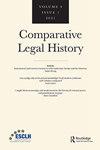Editorial
IF 0.5
Q2 LAW
引用次数: 0
Abstract
The journal has now reached its tenth volume, continuously offering a forum for comparative legal historians and their work. The content of the existing volumes attests that the journal endorses the efforts of the European Society for Comparative Legal History (ESCLH). Together, the journal and the ESCLH aim to develop and disseminate disciplinary studies that look at law across time and space. Issue 1 of Volume 10 offers methodological tools and exemplary studies that ought to be considered by those who aim to engage in comparative legal historical exercises. The articles section of this issue confirms the above statement by means of three articles. The first article, by Caroline Laske, offers a much needed toolbox that can be used when the subject of study relates to the language within a source. The author alerts readers of the usefulness of corpus linguistics methodologies when aiming to answer questions that require the unveiling of patterns in legal language usage and ways of encoding meanings. After all, language is a fundamental conduit for the law. The second article, by Gustaaf van Nifterik, offers an example of how the activities of actors – at different times and places – can be interconnected, with the potential of showing common, diverging, or recurring narratives. The author offers a ‘dialogue’ between Edward Coke, Fernando Vázquez de Menchaca, Jean Bodin, and Hugo de Groot on iurisdictio and imperium. The author does not hesitate to point to a Europe-wide process. The third article, by Ricardo Pelegrin Taboada, takes the readers to the Americas and analyses the development of the legal profession during the Spanish Colonial period and until the emergence of republics in the nineteenth century. The focus is on Mexico and Cuba, offering transatlantic and inter-American bridges. The author attends the different roles played by universities, bar associations, and the existing elites. The three articles in this issue confirm that comparative legal history is a discipline that cannot be circumscribed to a specific time and place, being therefore broad and diverse in its scope. The book reviews section of this issue presents a sample of the specialized literature that continues to develop in the field of comparative legal history. The first book reviewed deals with international law in West Africa under British colonialism, hence addressing a part of the Globe that continues to require more attention in the pages of the journal. The second book reviewed undertakes a comparative exploration of the relationship between guilds and the development of insurance, hence bridging an important lacuna in the field. The third book reviewed deals with a pillar of private law, looking at the family and marital property mainly around Northern Italy and the Austrian realm. That work offers valuable approaches from social anthropology and社论
该杂志目前已出版第十卷,不断为比较法律历史学家及其工作提供论坛。现有卷的内容证明,该期刊认可了欧洲比较法律史学会(ESCLH)的努力。该杂志和ESCLH共同致力于开发和传播跨时间和空间的法律学科研究。第10卷第1期提供了方法论工具和示范性研究,那些旨在从事比较法律历史实践的人应该考虑这些工具和研究。本期文章部分通过三篇文章证实了上述说法。Caroline Laske的第一篇文章提供了一个非常需要的工具箱,当研究主题与源语言相关时,可以使用它。作者提醒读者,在回答需要揭示法律语言使用模式和意义编码方式的问题时,语料库语言学方法是有用的。毕竟,语言是法律的基本渠道。Gustaaf van Nifterik的第二篇文章提供了一个例子,说明了演员在不同时间和地点的活动是如何相互关联的,有可能表现出共同、分歧或重复的叙事。作者提供了爱德华·科克、费尔南多·巴斯克斯·德·门查卡、让·博丁和雨果·德·格鲁特之间关于权力和统治的“对话”。作者毫不犹豫地指出了整个欧洲的进程。Ricardo Pelegrin Taboada的第三篇文章将读者带到美洲,分析了西班牙殖民时期法律职业的发展,直到19世纪共和国的出现。重点是墨西哥和古巴,提供跨大西洋和美洲之间的桥梁。作者关注大学、律师协会和现有精英所扮演的不同角色。本期的三篇文章证实,比较法律史是一门不能局限于特定时间和地点的学科,因此其范围广泛多样。本期的书评部分提供了在比较法律史领域继续发展的专门文献的样本。评论的第一本书涉及英国殖民主义统治下西非的国际法,因此谈到了《环球报》中仍然需要更多关注的部分。第二本书对行会与保险发展之间的关系进行了比较探索,从而填补了该领域的一个重要空白。第三本书论述了私法的一个支柱,主要关注意大利北部和奥地利王国的家庭和婚姻财产。这项工作提供了社会人类学和
本文章由计算机程序翻译,如有差异,请以英文原文为准。
求助全文
约1分钟内获得全文
求助全文
来源期刊
CiteScore
1.70
自引率
0.00%
发文量
20
期刊介绍:
Comparative Legal History is an international and comparative review of law and history. Articles will explore both ''internal'' legal history (doctrinal and disciplinary developments in the law) and ''external'' legal history (legal ideas and institutions in wider contexts). Rooted in the complexity of the various Western legal traditions worldwide, the journal will also investigate other laws and customs from around the globe. Comparisons may be either temporal or geographical and both legal and other law-like normative traditions will be considered. Scholarship on comparative and trans-national historiography, including trans-disciplinary approaches, is particularly welcome.

 求助内容:
求助内容: 应助结果提醒方式:
应助结果提醒方式:


